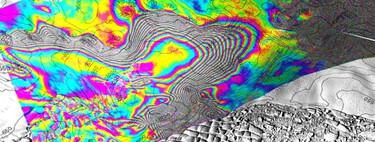In 1998, a survey of the seabed found mysterious holes off the California coast. These holes, similar to small underwater craters, had an unknown origin, although there has been much speculation since then. 25 years later, we have a new hypothesis to explain these curious characteristics of underwater orography.
New hypothesis. A new exploration of the South Pockmark Field holes has led a team of experts to postulate a new hypothesis about its appearance. The explanation proposed by a team led by researchers from the MBARI (Monterey Bay Aquarium Research Institute) would be simple gravity.
South Pockmark Field. The area where the mysterious holes are located is called South Pockmark Field (pockmark (This is the Anglo-Saxon term for this type of underwater crater.) This field is located off the coast of Big Sur, California and is made up of more than 5,200 of these small depressions.
The holes are found at a depth of between 500 and 1,500 metres. They have a diameter of about 200 metres and a depth of around five metres, although their size varies.
No trace of methane. Until now, the main hypothesis that explained these holes in the seabed was based on methane. This is because previous research has linked pockmarks similar ones found in other parts of the ocean with this gas. In those cases, methane bubbles rose from the subsoil, moving the sediments of the seabed with them.
To know if this was the case in this field of pockmarks was of special interest. The reason was in the projects to install offshore wind energy in this area. The existence of methane leaks could imply less stable soils, a potential problem for these developments.
Gravity doing its job. But the studies found no methane in the area. What they did find were indications that the holes could have been caused by “gravity sediment flows” – underwater avalanches that carry sediment to deeper areas of the ocean.
These flows would have been repeating themselves over the last 280,000 years. The movements, explains the MBARI teamseem to erode the center of the holes, encouraging these holes to persist over the years.
“We have compiled a wealth of data, allowing us to link pockmarks and sediment gravity fluxes. We were unable to determine exactly how these pockmarks initially formed, but (…) we gained new insight into how and why these features have persisted on the seafloor for hundreds of thousands of years,” Eve Lundsten pointed outco-author of the recent study.
Unmanned submarines. A study carried out thanks to the underwater technology used by the MBARI in the analysis. For the study the team first used a series of autonomous underwater vehicles, a type of self-guided unmanned submarine capable of bringing sonar closer to the seabed to achieve more precise mapping of the soil.
These maps facilitated the arrival of the second group of submarines, these being remotely guided vehicles (ROV). With these vehicles, the team was able to collect samples of the underwater soil to better understand the history of this geological area.
The details of the analysis were published in an article in the magazine Journal of Geophysical Research, Earth Surface.
In Xataka | 50 kilometers of underwater volcanoes under the Antarctic ice. The new discovery of an Italian expedition
Image | MBARI






![[Img #74675]](https://thelatestnews.world/wp-content/uploads/2024/12/They-discover-a-new-class-of-X-ray-sources-in-the-150x150.jpg)






![[Img #74675]](https://thelatestnews.world/wp-content/uploads/2024/12/They-discover-a-new-class-of-X-ray-sources-in-the-300x200.jpg)


Add Comment